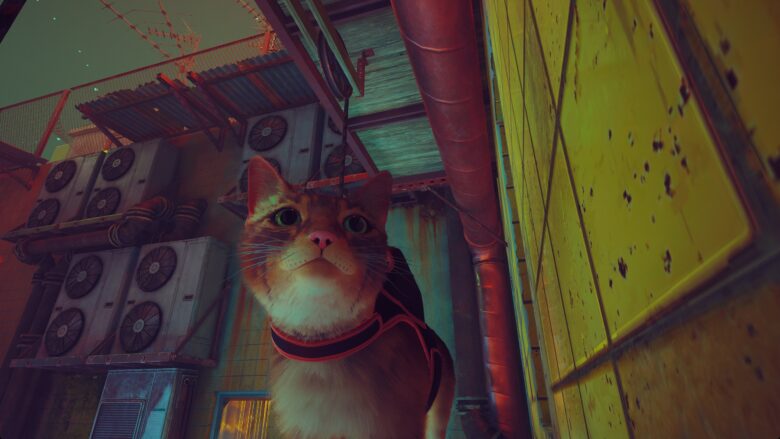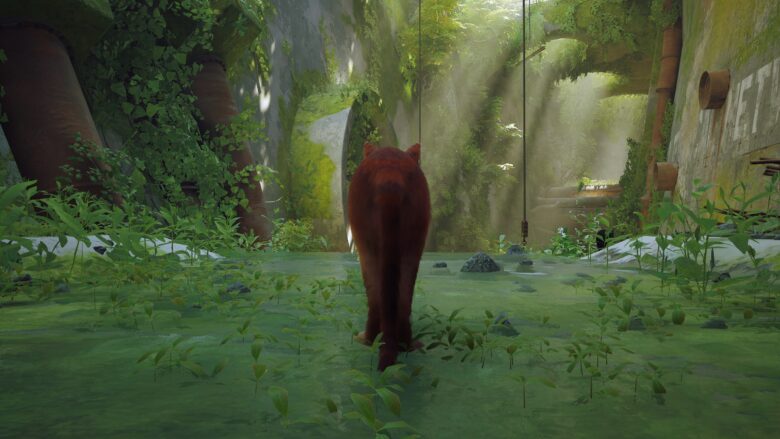In Stray, you play as a cat wandering through a cyberpunk version of the Kowloon Walled City, the most densely populated city in the world (and a fascinating footnote of history). In this future, though, the city teems with robots who dream of visiting the outside world.
It’s been out for PC, Xbox and PlayStation for a while, but the Mac version is out now on the Mac App Store.
Stray is a gripping game in an exquisitely designed and immersive world that proves gaming on the Mac is on the rise once again.
Stray review: A story-driven game about a cat in the city

Screenshot: D. Griffin Jones/Cult of Mac
Stray is a largely story-driven game. The controls are simple. As you jump up ledges or cross railings, you just press a button or walk forward. You’re not playing against the physics of the game, like Super Mario 64 — cats always jump perfectly and cats never trip.
This frees you up to climb, explore and solve the game’s puzzles.
You have a dedicated Meow button. It usually doesn’t do anything, but it’s always there. You can scratch the couch when you walk into a room, or bat objects off of tables. You can rub up against people’s legs to win their love and affection. If the mood strikes, you can even walk across a keyboard and fill the screen with random letters.
An open world for your feline adventures

Screenshot: D. Griffin Jones/Cult of Mac
The story is railroaded, but the game is open-world enough to make discoveries feel earned. It also allows for random side missions (like finding sheet music to give to a street guitar player).
You spend quite a lot of time in the first act scaling buildings by jumping from pipe to porch to railing to awning to air conditioner. The next portion of the game sends you on a big scavenger hunt, seeking out the object you need to find the next object you need to repair the next object to give to a person to unlock the next plot line, and so on. In the last act, you stealthily dodge security drones through a maze of rooms and hallways, as you make a tense escape.
There are occasional areas that switch up the action, where you must race through dilapidated buildings overrun with goo monsters. These levels provide just the right degree of challenge. I had to replay some sections a few times, but Stray is great at autosaving after each challenge so you don’t get frustrated losing progress.
Immersive, rich environments to lose yourself in

Screenshot: D. Griffin Jones/Cult of Mac
The world in this game is simply incredible. The streets look incredibly dense and lived in. Like they’re hundreds of years old. Graffiti, pools of murky water in crumbling streets, papers randomly stuck onto walls — the sort of urban carnage that is so hard to artificially create to such perfection.
Rooms and environments are absolutely littered with garbage. Bottles, boxes, electronics, cans, books, newspapers, etc. The collision detection works great 99% of the time, sending things tumbling or rolling realistically with sound effects to match; occasionally, objects randomly fly into the sky or clip through a wall.

While great care has been taken in giving your cat a plethora of natural animations that perfectly transition from one to the next, a glaring omission is that robot characters don’t animate up stairs whatsoever. They continue walking flat across an invisible floor as they glide up the stairs. It’s not a cut corner in a hidden background detail. It features prominently in several significant parts of the game.
But minor quibbles aside, I’m amazed by the level of pacing, detail and polish in Stray. That fact that only five level designers receive credit seems unbelievable.
Stray proves gaming on the Mac is coming back
You can’t talk about a big game on the Mac without looking at the big picture of Mac gaming.
PC gaming is an ever-rising hill, whereas Mac gaming comes and goes like the tide. A brief heyday in the 90s was squashed in the transition to Mac OS X. Another peak hit during the Intel era around ten years ago — but Mac hardware started to languish, macOS Catalina killed 32-bit apps (and consequently, most Steam games) and Apple silicon reset the playing field once again.
The last four years of Mac sales have all been better than the best ever. And every M-series Mac can play modern 3D games. The stage is set for a new market of Mac gamers.
Impressive graphics for everybody

Screenshot: D. Griffin Jones/Cult of Mac
What makes the Apple silicon Mac great for gaming is that it significantly lowers the barrier to entry. Even the basic M1 chip delivers competent graphics. The new M3 chip that inevitably will trickle down to the $599 Mac mini (likely sometime next year), benefits from hardware-accelerated ray tracing and mesh shading, for crying out loud.
But Apple silicon’s system-on-a-chip design lowers the ceiling, too. You can’t add a graphics card down the road for extra oomph, as PC gamers like to do. You can buy a Mac with an M-series Max or Ultra chip inside … if you have that much money to burn up-front.
How Stray looks on an M2 Mac mini

Screenshot: D. Griffin Jones/Cult of Mac
Personally, I’m running a Mac mini with M2 Pro with a 10-core CPU and 16-core GPU. I could have spent $300 for the 12- and 19-core chip, but I spent my budget upgrading RAM and storage to 32 GB and 2 TB. Any Mac mini with M2 Pro, available new for just $1,299, should look this good. (All of the screenshots in this article I took myself using this machine.)
I was in awe that these graphics came from my tiny little computer with no fan noise, no dropped frames, no struggle. I put my hand on the case after a while and felt a bit of warmth — that’s about it. And you better believe I cranked all the graphics settings up to High before I even started.
You don’t need a gigantic tower with fans blowing up a dust storm and a GPU the size of an encyclopedia. The computer itself is probably the last thing you’d notice when you look at my computer desk.
Stray final thoughts

Screenshot: D. Griffin Jones/Cult of Mac
Stray is one more in a growing number of Mac titles. It’s half the cost of a standard AAA game at only $29.
In my first playthrough for this review, I rushed through the storyline and hit the credits in 6 hours 11 minutes of gameplay. I bet if you take your time, you could easily double the hours finding all the secrets, talking to all the NPCs and completing all the sidequests to get even more of your money’s worth.
Not a lot of games wind up ported to macOS. But Stray proves that the Mac could become a great gaming platform once again.
Buy from: Mac App Store
★★★★★
![Meow! Stray proves great gaming can happen on a Mac [Review] Photo of the Stray title screen on a Mac, with two cats sitting on the desk nearby](https://www.cultofmac.com/wp-content/uploads/2023/11/Stray-for-Mac-1536x1152.jpg)

